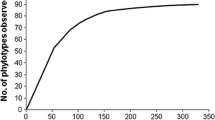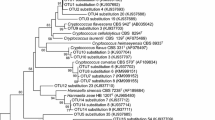Abstract
Yeast-like symbiotes (YLS) are endosymbionts that are intimately associated with the growth, development, reproduction of their host, the brown planthopper, Nilaparvata lugens (Hemiptera: Delphacidae). However, it is unclear how many species of YLS are found within N. lugens, and how they are related to each other. Traditional methods or simple amplification based on 18S rDNA sequence does not reliably identify new species quickly and efficiently. Therefore, a novel nested PCR-denaturing gradient gel electrophoresis (DGGE) strategy was developed in this article to analyze the YLS of brown planthopper using a nested PCR protocol that involved the 18S rDNA gene and the 5.8S–ITS gene using fungal universal primers. The nested PCR protocol was developed as follows: firstly, the 18S rDNA gene, and 5.8S–ITS gene were amplified using fungal universal primers. Subsequently, these products were used as a template in a second PCR with primers ITS1GC–ITS2, ITS1FGC–ITS2, and NFGC-NR, which was suitable for DGGE. Using this highly specific molecular approach, we found several previously detected fungi: Noda, Pichia guilliermondii, Candida sp., and some previously undetected fungi, such as Saccharomycetales sp., Debaryomyces hansenii, and some uncultured fungi. In conclusion, the nested PCR system developed in this study, coupled with DGGE fingerprinting, offers a new tool for uncovering fungal endosymbiont diversity within planthoppers.





Similar content being viewed by others
References
Borresen AL, Hovig E, Brogger A (1988) Detection of base mutations in genomic DNA using denaturing gradient gel electrophoresis (DGGE) followed by transfer and hybridization with gene-specific probes. Mutat Res Fundam Mol Mech Mutagen 202:77–83
Chen CC, Cheng LL, Hou RF (1981) Studies on the intracellular yeast like symbiote in the brown planthopper, Nilaparvata lugens Stål II. Effects of antibiotics and elevated temperature on the symbiotes and their host. J Appl Entomol 92:440–449
Chen FJ, Ceng M, Zhang JF et al (2006) Morphological difference of the yeast-like endosymbiotes in adult planthoopers of Nilaparvata lugens (Stål), Laodelphax striatellus (Fallen) and Sogatella furcifera (Horvath). Acta Zootaxonomica Sinica 31:728–735
Chen YH, Bernal CC, Jing T et al (2011) Planthopper adaptation to resistant rice varieties: changes in amino acid composition over time. J Insect Physiol 57:1375–1384
Doare-Lebrun E, El Arbi A, Charlet M et al (2006) Analysis of fungal diversity of grapes by application of temporal temperature gradient gel electrophoresis potentialities and limits of the method. J Appl Microbiol 101:1340–1350
Dong SZ, Pang K, Bai X et al (2011) Identification of two species of yeast-like symbiotes in the brown planthopper, Nilaparvata lugens. Curr Microbiol 62:1133–1138
Fang HHP, Zhang T, Liu Y (2002) Characterization of an acetate-degrading sludge without intracellular accumulation of polyphosphate and glycogen. Water Res 36:3211–3218
Felske A, Wolterink A, Lis R et al (1999) Searching for predominant soil bacteria: 16S rDNA cloning versus strain cultivation. FEMS Microbiol Ecol 30:137–145
Ferris MJ, Muyzer G, Ward DM (1996) Denaturing gradient gel electrophoresis profiles of 16S rRNA-defined populations inhabiting a hot spring microbial mat community. Appl Environ Microbiol 62:340–346
Gardes M, Bruns TD (1993) ITS primers with enhanced specificity for basidiomycetes application to the identification of mycorrhizae and rusts. Mol Ecol 2:113–118
Gray M, Charpentier A, Walsh K et al (1991) Mapping point mutations in the Drosophila rosy locus using denaturing gradient gel blots. Genetics 127:139–149
Heinrichs EA (1985) Genetic evaluation for insect resistance in rice. International Rice Research Institute, Los Banos
Kagayama K, Shiragami N, Nagamine T et al (1993) Isolation and classification of intracellular symbiotes from the rice brown planthopper, Nilaparvata lugens, based on analysis of 18S-ribosomal DNA. J Pest Sci 18:231–237
Lee YH, Hou RF (1987) Physiological roles of a yeast-like symbiote in reproduction and embryonic development of the brown planthopper, Nilaparvata lugens, Stål. J Insect Physiol 33:851–860
Liang HW, Wang CZ, Li Z et al (2008) Improvement of the silver-stained technique of polyacrylamide gel electrophoresis. HEREDITAS (Beijing) 30:1379–1382
Liu WT, Chan OC, Fang HHP (2002) Microbial community dynamics during start-up of acidogenic anaerobic reactors. Water Res 36:3203–3210
Liu WT, Marsh TL, Cheng H et al (1997) Characterization of microbial diversity by determining terminal restriction fragment length polymorphisms of genes encoding 16S rRNA. Appl Environ Microbiol 63:4516–4522
Lu ZX, Yu XP, Chen JM et al (2004) Dynamics of yeast-like symbiote and its relationship with the virulence of brown planthopper, Nilaparvata lugens Stål, to resistant rice varieties. J Asia Pac Entomol 7:317–323
Muyzer G, De Waal EC, Uitterlinden AG (1993) Profiling of complex microbial populations by denaturing gradient gel electrophoresis analysis of polymerase chain reaction-amplified genes coding for 16S rRNA. Appl Environ Microbiol 59:695–700
Muyzer G, Smalla K (1998) Application of denaturing gradient gel electrophoresis (DGGE) and temperature gradient gel electrophoresis (TGGE) in microbial ecology. Anton Leeuw Int J G 73:127–141
Nasu S, Kusumi T, Suwa Y et al (1981) Symbiotes of planthoppers: II. Isolation of intracellular symbiotic microorganisms from the brown planthopper, Nilaparvata lugens Stål. and immunological comparison of the symbiotes associated with rice planthoppers (Homoptera: Delphacidae). Appl Entomol Zool 16:88–93
Noda H, Kodama K (1996) Phylogenetic position of yeastlike endosymbionts of anobiid beetles. Appl Environ Microbiol 62:162–167
Noda H, Nakashima N, Koizumi M (1995) Phylogenetic position of yeast-like symbiotes of rice planthoppers based on partial 18S rDNA sequences. Insect Biochem Mol Biol 25:639–646
Noda H, Omura T (1992) Purification of yeast-like symbiotes of planthoppers. J Invertebr Pathol 59:104–105
Ogier JC, Son O, Gruss A et al (2002) Identification of the bacterial microflora in dairy products by temporal temperature gradient gel electrophoresis. Appl Environ Microbiol 68:3691–3701
Pang K, Dong SZ, Hou Y et al (2012) Cultivation, identification and quantification of one species of yeast-like symbionts, Candida, in the rice brown planthopper, Nilaparvata lugens Stål. Insect Sci 19:477–484
Sasaki T, Kawamura M, Ishikawa H (1996) Nitrogen recycling in the brown planthopper, Nilaparvata lugens: involvement of yeast-like endosymbionts in uric acid metabolism. J Insect Physiol 42:125–129
Stach JEM, Bathe S, Clapp JP et al (2001) PCR-SSCP comparison of 16S rDNA sequence diversity in soil DNA obtained using different isolation and purification methods. FEMS Microbiol Ecol 36:139–151
Tang M (2010) Bacterial symbionts of the brown planthopper, Nilaparvata lugens (Homoptera: Delphacidae). Appl Environ Microbiol 76:1740–1745
Uitterlinden AG, Slagboom PE, Knook DL et al (1989) Two-dimensional DNA fingerprinting of human individuals. Proc Natl Acad Sci USA 86:2742–2746
White TJ, Bruns T, Lee S et al. (1990) Amplification and direct sequencing of fungal ribosomal RNA genes for phylogenetics. PCR protocols a guide to methods and applications. p 315–322
Wilkinson TL, Ishikawa H (2001) On the functional significance of symbiotic microorganisms in the Homoptera: a comparative study of Acyrthosiphon pisum and Nilaparvata lugens. Physiol Entomol 26:86–93
Zhang J, Chen J, Chen F et al (2009) The isolation of yeast-like symbiots in the brown planthopper and the sequences analysis of its 26S rDNA. Scientia Agric Sinica 42:2211–2216
Zhang J, Wu H, Chen J et al (2007) A strain isolated from brown planthopper and its molecular identification. Chin J Rice Sci 21:551–554
Zhang T, Fang H (2001) Phylogenetic diversity of a SRB-rich marine biofilm. Appl Microbiol Biotechnol 57:437–440
Zhou C, Zhang X, Wang G (2006) Several methods for yeast identification. China Brewing 8:51–54
Acknowledgments
This study was partly supported by the National Basic Research Program of China (Grant No. 2011CB111602, 2012CB114100, 2010CB126200), Zhejiang Provincial Natural Science Foundation of China (Grant No. Z3100594), and the National 863 Project (Grant No. 2012AA021601).
Author information
Authors and Affiliations
Corresponding author
Additional information
Yun Hou and Zheng Ma contributed equally to this article and should be considered co-first authors.
Rights and permissions
About this article
Cite this article
Hou, Y., Ma, Z., Dong, S. et al. Analysis of Yeast-Like Symbiote Diversity in the Brown Planthopper (BPH), Nilaparvata lugens Stål, Using a Novel Nested PCR-DGGE Protocol. Curr Microbiol 67, 263–270 (2013). https://doi.org/10.1007/s00284-013-0356-z
Received:
Accepted:
Published:
Issue Date:
DOI: https://doi.org/10.1007/s00284-013-0356-z




